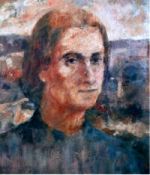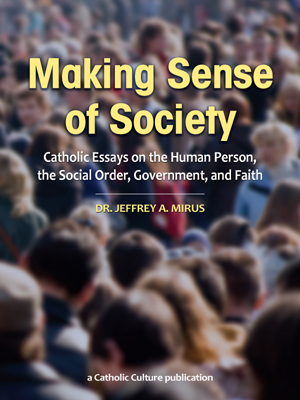The Human Heart of Jesus
.
Our First Intimations of the Sacred Heart Come in Our First Earthly Moments
St. Thomas Aquinas taught that if you want to build up the faith, you should begin by understanding nature. Meditation on the creation is indeed necessary in order to build up man's faith in God. Considering God's works, we are able to admire the wisdom and power of God. This admiration, then, moves us to reverence and to love of God.
The study of creation is necessary not only for the building up of faith, but for the destruction of errors. The philosopher Jacques Maritain pointed out that there is a tendency for Catholics to suffer from the sin of sacramentalism, dismissing nature in favor of the sacrament, as if all you have to do is to be open to grace to make your way in the world. But grace can only build upon nature.
I would like, then, to consider the human heart.
From the very moment of our conception, we are brought up under the umbrella of a mother's pulsating heart. We go through the whole embryological, fetal period, for nine months, having our tensions relieved, gaining our peace, by the regular rhythmic pulsating of the mother's heart. We live in an environment where, as unborn infants, we receive our oxygen from the mother without having to breathe, we get our food through the mother's circulation without having to eat. It is a peaceful existence always associated with the reassurance of a living mother, detected by the pulsating heart.
Our own heart comes into existence about 25 days after fertilization. If you consider this heart in proportion to the rest of the body, it is, at six weeks' gestation, around nine times the size of an adult heart. And the little embryo, which is now around a quarter of an inch, is bent over because it has a big head, and its head is leaning against its own pulsating heart, and its heart tone is beating in harmony with the mother's heart tone.
When the newborn baby is born into the world — a strange world with considerable motion, light and noise — the baby is now cold. It has gone through a very hard experience, coming down the birth canal. What will reassure this baby? It is the mother's bosom. The newborn goes directly to the mother's breast, and there it hears an old familiar tune, the pulsating beat of the mother's heart. And the baby once again feels secure.
Research shows that if you observe several hundred right-handed mothers, 80 percent of them will hold their babies on the left side. Observe left-handed women, and you'll find, again, that 80 percent of them hold their babies on the left side. Both groups, whether right- or left-handed, hold the baby close to the heart. If you ask left-handers why they do this, they'll reply, "Because I'm left-handed and can hold my baby more securely this way." If you ask right-handers, they'll say, "I'm right-handed, and holding my baby on the left frees my right hand to do other things."
These are rationalizations. Both groups are holding their babies on the left side for some reason that is obscure to them. It is not obscure to the baby.
Neither the child's heart nor the mother's heart accomplishes this peace on its own. Each is part of a constellation.
Consider the human and Sacred Heart of Jesus, which Pope John XXIII described as throbbing mysteriously behind the eucharistic veils. Pope Paul VI said that the Eucharist is the outstanding gift of the Sacred Heart.
When the baby is held to the mother's breast, the outstanding gift is the mother's milk. Thus the Sacred Heart is to the Eucharist as the mother's heart is to maternal milk, the milk of kindness. In both cases, we are relating the heart to food, to sustenance.
And what does the baby do most of the time at the mother's breast? It is looking at the mother's face. Mothers have long known what doctors have only recently found out: that babies can see, they can hear and they can smell. A baby can identify mother within 48 hours of birth. At the breast, nature has placed the baby at the optimum position and distance to see the mother's face.
Note, then, that when we want an expression of love from God, we ask Him to show His face to us: "Lord, let your face shine on us, and we shall be saved" (Ps 80:3). "May God show kindness and bless us and make His face smile on us" (Ps 67:1).
This is a very moving one: "If my father and mother desert me, Yahweh will care for me still" (Ps 27:10). This is the difference with the Sacred Heart. The Sacred Heart never fails to love a person, whereas sometimes parents can fail their children.
As we consider God's face, and the Eucharist, and the pulsating heart, the Sacred Heart, we discern a constellation that reflects what nature intends.
Moreover, Pope Pius XII said: "In order that favors may flow in great abundance on all Christians, even on the whole human race, from devotion to the Sacred Heart of Jesus, let the faithful see to it that to this devotion the Immaculate Heart of the Mother of God is closely joined."
The grace that comes from the Sacred Heart, the grace that comes from God's smiling face, the grace that comes from the Eucharist, all together make good the promise of nature from our earliest moments of life. •
Adapted from a 1979 address by Dr. Herbert Ratner, the renowned philosopher of medicine, who died at age 90 last December. New Covenant magazine, to subscribe write Our Sunday Visitor, Inc., 200 Noll Plaza, Huntington, IN 46750-9957 or call 1-800-348-2440. Published monthly at a charge of $18.00 per year. This item 434 digitally provided courtesy of CatholicCulture.org






